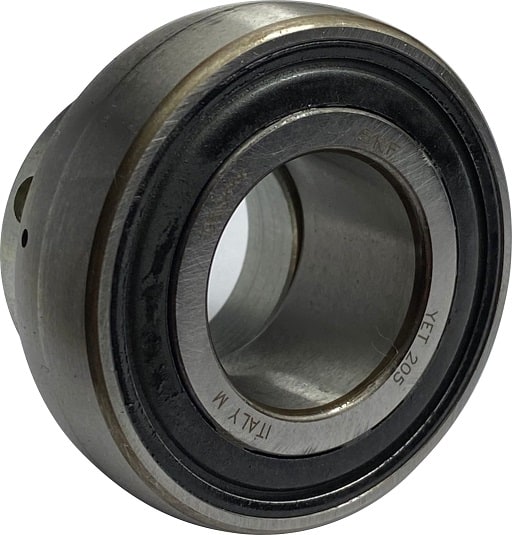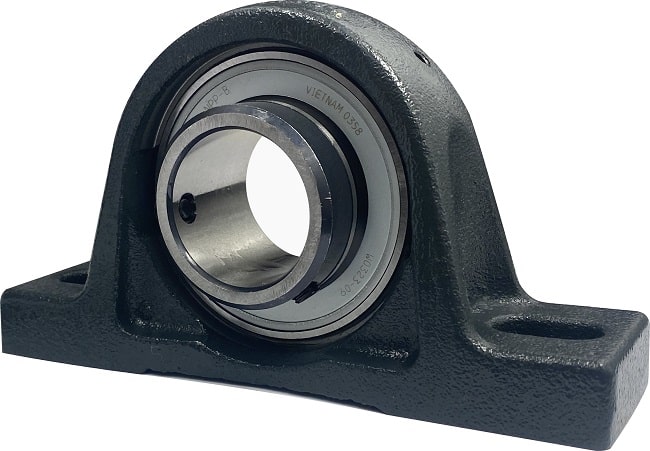Radial insert ball bearings
Startseite » Rolling bearings » Radial insert ball bearing
Charakteristics of radial insert ball bearings
Radial insert ball bearings or Y-bearings are ready-to-fit units which are available as plummer blocks or flanged units. They consist of a single-row deep groove ball bearing with a spherical outer surface and seals on both sides. Misalignments can be compensated for by the static pendulum function between the outer ring and housing.
Mounting options on the widened inner ring facilitate simple and quick mounting on the shaft. Common types of mounting on the shaft are the grub screw mounting and the eccentric ring mounting. Depending on the design of the radial insert ball bearing, housing bearing units are mounted on the shaft by means of set screws in the inner ring, eccentric ring and set screw, adapter sleeve, interference fit or via a profiled bore. Which fastening method is most suitable depends on the particular application. In addition to the maximum permissible speed, the direction of rotation of the shaft and the running behavior as well as the effect of axial loads must also be taken into account.
Fastening options for the radial insert ball bearings
Mounting with grub screws
Grub screws as a fastening option are among the simplest and most economical fastening options. Here, the inner ring is equipped with two grub screws offset by 120°. When both grub screws are tightened, the inner ring is braced on the shaft and fixes the unit in place. When tightening, the recommended tightening torque must be observed. This type of mounting for radial insert ball bearings is suitable for not too high loads even with alternating directions of rotation.
Mounting with eccentric ring
In the eccentric ring fixing for radial insert ball bearings, the eccentric ring is pushed over the inner ring collar and turned in the direction of rotation of the shaft until it clamps. Care must be taken to ensure that the eccentric ring is clamped in the direction of rotation of the shaft and finally secured with a grub screw. At higher speeds, the eccentric ring is only suitable if the direction of rotation remains constant, because the eccentric ring can become loose if the direction of rotation changes. With this method, the larger installation space must be taken into account due to the additional component.

Mounting with adapter sleeves
Similar to spherical roller bearings, bearing inserts can also have a tapered bore. Adapter sleeves are generally used to mount these bearing inserts. Adapter sleeves are generally a very secure mounting method. During mounting, the bearing is pushed onto the sleeve until the recommended reduction in radial internal clearance is achieved. Setting the correct bearing clearance value is critical to bearing life. The lock washer and locknut are used to secure the bearing in this position. With this mounting method, one benefits from a very high holding force, low-vibration running and higher speeds.
Other mounting options
The radial insert ball bearings can also be mounted on the shaft with an interference fit. In this case, the so-called surrounding construction must be designed as for standard deep groove ball bearings. The characteristics of the bearing (direction of rotation, speed, etc.) are then identical to those of standard bearings.
In the case of radial insert ball bearings with a profiled bore, the mounting or anti-rotation protection on the shaft takes place by means of a form fit. These radial insert ball bearings are predestined for bearing arrangements where the shaft has to transmit extremely high torques and this is only possible with square or hexagonal shafts. This type of bearing is manufactured with plus tolerance in the bore, which makes them particularly easy to mount and dismount. They are axially fixed on the shaft via conversion parts.
Radial insert ball bearing housing units
Radial insert ball bearing housings are available in the variants plummer block, flanged bearing and radial insert ball bearing head housings. They are optionally made of polyamide or polyester, cast iron or sheet steel. Housing bearing units with housings made of sheet steel do not permit high loads, are only suitable for moderate speeds and cannot be relubricated. Since the radial insert ball bearing housings are two-piece units, they are easy to assemble and equally inexpensive to purchase. They are primarily used in applications where lower weight is of greater importance than the load carrying capacity of the housing.
In contrast, insert ball bearing housings made of cast iron are one-piece and can support significantly higher radial and axial as well as shock loads. For this reason, they are suitable for bearing arrangements that have to support high loads. They can also be relubricated, which is why they are used in applications with high speeds and where relubrication is required.
The permissible speeds for housing bearing units are primarily dependent on the type of mounting on the shaft as well as the type of sealing. In general, higher speeds are possible with the concentric mounting methods of the radial insert ball bearings by means of an adapter sleeve or a close fit. In the case of radial insert ball bearings with grub screw mounting or with eccentric ring mounting, the selected shaft tolerance also has an influence on the permissible speed. The higher the respective tolerance class, the lower the permissible speed. Housing bearing units are suitable for drawn shafts of quality h6 to h9.
In contrast to standard metric bearings, the bores in insert ball bearings are manufactured with a plus tolerance. This results in transition or sliding fits for shafts with h tolerances.
Due to the spherical seat of the outer rings in the housing and the mounting on the shaft, housing bearing units do not normally allow the formation of a locating and non-locating bearing arrangement. The respective bearing spacing must therefore not be very large, or the entire arrangement must be selected so that axial compliance is guaranteed. However, if axial displaceability is absolutely necessary, screws with journals can be inserted in the threaded holes to engage in a shaft keyway.
PACH Systems offers you a wide product range of different radial insert ball bearings. For this purpose we cooperate with our long-term partners. Please let us know your requirements via our contact form. We will be happy to provide you with a non-binding offer or contact you to discuss the details.


